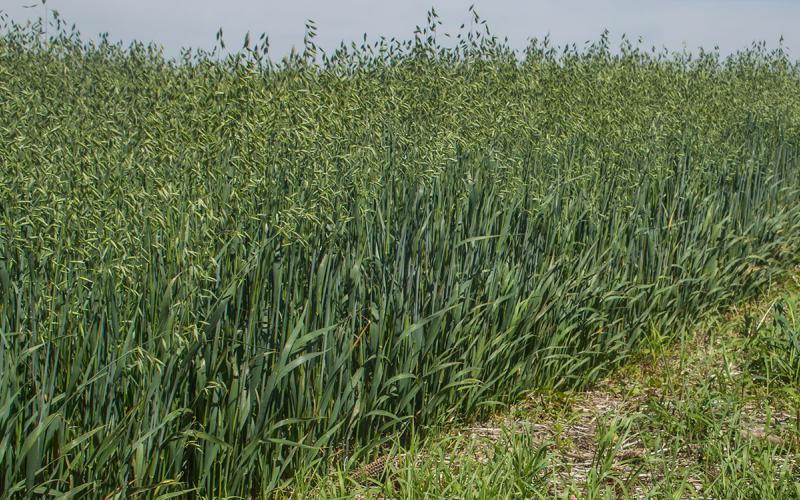
Can short-term backgrounding diets of beef calves have long term impacts of meat quality? Recent research from the meat science team at South Dakota State University (SDSU) says “Yes.” In a study published in two parts in the journals of Translational Animal Science and Foods, we looked at the impact a harvested brassica cover crop diet fed for a 44-day period post-weaning had on growth performance, carcass characteristics and meat quality.
How did we do it?
Thirty angus-based weaned steer calves were divided into two treatments. One treatment received a common Midwestern dry-lot diet containing silage, soybean meal, grass hay and a liquid supplement for vitamins and minerals. This diet was considered the experimental control. The other treatment received ad libitum access to freshly harvested brassica tops, including radish, turnip, rapeseed and rye grass along with the same liquid supplement. The cover crops were harvested daily using a sickle bar mower and processed through a forage harvester to achieve approximate equal particle size to avoid sorting. The steers were fed using the Insentec RIC system at the SDSU Cow Calf Education and Research Facility. The Insentec system makes it possible to feed custom diets with different ingredients to animals housed in the same pen by only allowing certain animals to eat from certain bunks. It also tracks individual feed disappearance by weighing the feed bunk before and after an animal has a meal. We were able to keep the diets between the two treatments nutritionally similar by calculating the dry matter each animal in the cover crop treatment consumed each day and altering the amount of feed each animal in the control group was allowed to eat the following day. By keeping the diets nutritionally similar, we were able to control growth through the experimental phase to ensure any differences observed at the end of the study were a result of the diet ingredients, not from the animals being at different nutritional statuses.
Once the experimental backgrounding phase was over, the steers were acclimated to a common step-up and finishing diet and fed to an average endpoint of 0.4 inches of backfat by visual estimation. The steers were harvested at a commercial meat processing plant and strip loins were collected for further analysis. We fabricated the strip loins into 1-inch-thick strip steaks and evaluated color, tenderness, and the chemical composition of the steak to determine the amount of marbling. Tenderness was evaluated on four steaks per strip loin that were wet aged for four, seven, 14 or 21 days postmortem.
What did we learn?

We observed no differences in the average daily gain, dry matter intake, gain to feed ratio, or body weight between the two treatments during the backgrounding or finishing phases. However, we did see a slight improvement in overall (backgrounding and finishing phases combined) gain-to-feed ratio for steers in the control group compared to the cover crop group. We also saw no differences in the carcass characteristics of hot carcass weight, ribeye area, backfat thickness, marbling score or yield grade, in addition no differences in color or chemical composition were observed. These results meant that we could conclude that there were no implications of backgrounding diet on live performance or carcass characteristics, which are the factors most producers and feed lots are concerned with.
However, when we evaluated tenderness, the steaks from each treatment behaved differently during the first week of postmortem aging. Strip steaks from steers fed the cover crop diet reached their ultimate tenderness by seven days postmortem. It took the steaks from steers fed the control diet 14 days to reach ultimate tenderness. At 14 days, the steaks from both treatments were similar in tenderness.
"Strip steaks from steers fed the cover crop diet reached their ultimate tenderness by seven days postmortem. It took the steaks from steers fed the control diet 14 days to reach ultimate tenderness. At 14 days, the steaks from both treatments were similar in tenderness."
While most producers do not get any premiums for having tender meat, this information can be particularly helpful for producers who direct market or sell animals for custom processing. This is because many small processors have beef carcasses cut and frozen within one week of harvesting the animal. Once meat is frozen, the aging process stops, and the meat will not tenderize any further. By capitalizing on this earlier peak in tenderness, producers can offset the potential loss of tenderness development caused by early freezing.
We acknowledge that this study was not done to real-life standards, as nobody has the time to harvest cover crops daily. However, the data are promising in that marked improvements in tenderness are possible even in a six-week period over 200 days prior to harvest. Also, worthy to note, is that no adverse impacts on performance or carcass characteristics were observed, which opens the door for a background feeding alternative for those producers with cover crops available for grazing.
Translational Animal Science and Foods are open-access journals. You can read the full studies below.
Full Studies
- Bakker, C.E., L.M. Hite, C.L. Wright, D. W. Brake, A.J. Smart, A.D. Blair, J.K. Grubbs, K.R. Underwood. 2021. Impact of feeding cover crop forage containing brassicas to steers during backgrounding on live animal performance, carcass characteristics, and meat color. Translational Animal Science 5(3). Txab124. https://academic.oup.com/tas/article/5/3/txab124/6326498
- Bakker C., L. Hite, C. Wright, A. Smart, T. Dinh, A. Blair, K. Underwood, and J. K. Grubbs. 2021. Impact of Feeding Cover Crop Forage Containing Brassicas to Steers during Backgrounding on Palatability Attributes of Beef Strip Steaks. Foods. 10(6). 1250.


